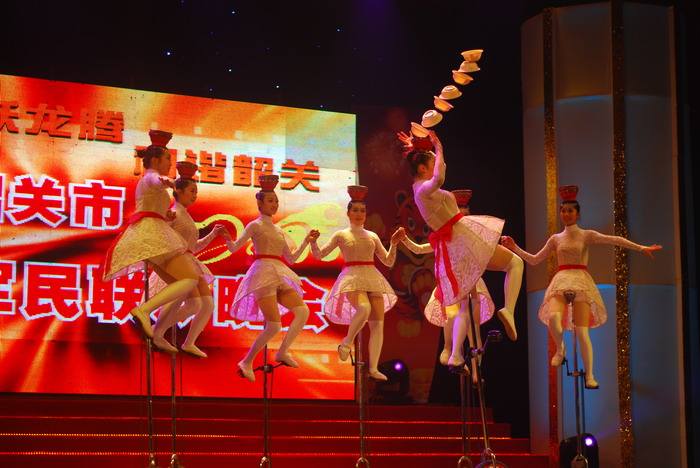Acrobatics Derived from Farming
3 min readPagoda of Bowls and the Tradition of Hospitality
Pagoda of Bowls byXia Juhua(c.1950’s)
The use of common household objects such as bowls and cups as acrobatic props has a long history. As powerful symbols of abundance, bowls were often balanced on the head as a token of high esteem and gratitude when making sacrifices to Heaven, Earth, and ancestors. This custom, prevalent throughout China, is illustrated in a precious cultural artifact dating from the Shang Dynasty(c. early 17th-11th century BC),”Jade Figure Bearing Bowl on Head.”With the passage of time, the act of balancing bowls on the head gradually evolved from an entreaty to the gods into an entertainment for the people, and was often performed to express hospitality. Even today, in many regions in China the ancient customof balancing bowls on the head when greeting, wining, and dining guests has been retained. Acrobatic bowl balancing, which evolved from this folk custom, was already popular during the Han Dynasty(206BC-220AD), with lifelike portrayals found in Han Dynasty tomb carvings in Henan, Shandong, and Sichuan provinces.
The modern acrobatic act Pagoda of Bowls involves balancing a stack of ten or more large bowls on the head while executing a variety of graceful movements and feats of balance. This technique has developed rapidly over the last fifty years. Acrobat Xia Juhua’s gold medal winning performance of Pagoda of Bowls at the World Youth Festival in 1957 stimulated new interest in creating innovativebowl balancing acts. Since then, China’s acrobatic artists have truly “let a hundred flowers bloom,”developing numerous new variations including Pagoda of Bowls with Contortions, Pagoda of Bowls byHuman Tower, Three People with Pagoda of Bowls on Ladder, Pagoda of Bowls by Tower of Women, Pagodaof Bowls on Flying Benches, and Partners with Pagoda of Bowls. In the last two decades, more than a dozen Chinese bowl balancing acts have won top awards at major international competitions.

Mid-air toss and catch in Pagoda of Bowls
Pole Climbing and Fruit Picking
The origins of acrobatic Pole Climbing acts can be traced back to ancient times, when climbing trees to gather fruit was a common form of agricultural labor. Many tree climbing techniques were passed down through the ages, and eventually adapted into acrobatic acts. The earliest mention of acrobatic Pole Climbing dates from a royal entertainment popular in the State of Jin during China’s Spring and Autumn(770-476 BC) and Warring States(475-221 BC) periods. In this act, known as “Pole Climbers of Short Stature,”dwarf acrobats performed comic stunts on tall spear shafts. Pole Climbing acts con-tinued to develop over the following 2,000 years. Modern techniques are many and varied, involvingstunts, leaps, flips, and contortions performed on fixed, unfixed, and suspended poles, poles balanced on the head or shoulders, and poles held in the hand. Today, Pole Climbing is a must in the repertoire of any Chinese acrobatic troupe.
No matter the variation, Pole Climbing demands extraordinary strength and balance as the performer clambers up and down the pole at lightning speed, all the while executing complex contortions and stunts. Always searching for new innovations, acrobatic artists have replaced the traditional bamboc pole with much more slippery and challenging metal poles, and added various types of slanted and fixed poles to the original fixed pole. Stunts on a single fixed pole have evolved into thrilling moves of precise coordination and timing on multiple poles, as two or more artists toss and flip each other back and forth and fly from pole to pole in complex interweaving patterns. Combining strength and grace, acrobatic Pole Climbing continues to win a growing number of fans.








